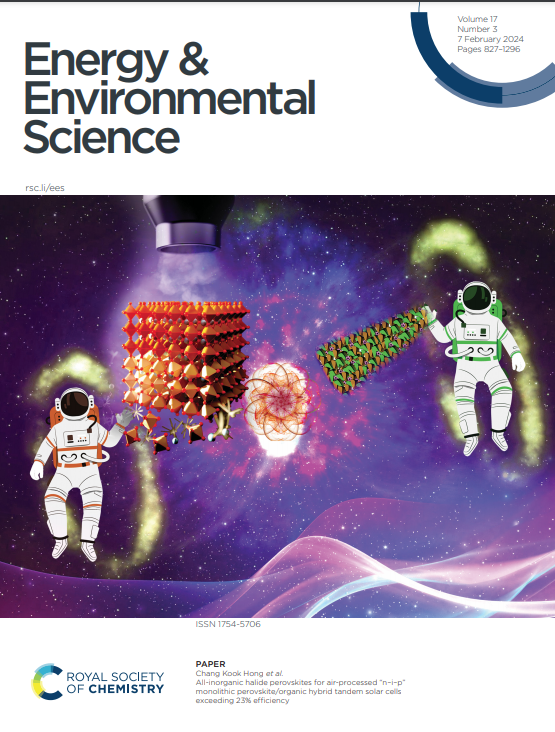A Multifunctional Natural Polymer Protective Layer Enables Improved Anti-Corrosion and Kinetics Performances for Highly Stable Zinc Anode
IF 30.8
1区 材料科学
Q1 CHEMISTRY, MULTIDISCIPLINARY
引用次数: 0
Abstract
Aqueous zinc-ion batteries (AZIBs) featuring high theoretical capacity, intrinsic safety, and cost-effectiveness are emerging as an ideal candidate for grid-scale energy storage devices. Unfortunately, their practical application is severely impeded by parasitic side reactions and rampant dendrite growth. Herein, a free-standing multifunctional polymer framework based on natural Nicandra physaloides (L.) Gaertn pectin (NPGP) is fabricated by a facile one-step method without additional binders. Theoretical calculations and comprehensive experiments disclose that the 3D continuous skeleton structure and abundant polar groups of the NPGP protective layer synchronously suppress water-mediated side reactions, enhance the interface kinetics, and expedite Zn2+ desolvation. Meanwhile, scanning electrochemical microscopy and small-angle neutron scattering further reveal that the NPGP ensures dendrite-free Zn deposition. Benefiting from the multifunctional synergistic interface regulation, the NPGP-modified Zn anodes deliver an ultra-long cycling lifespan exceeding 5620 h, along with an exceptional average Coulombic efficiency of 99.64% over 1740 cycles. Additionally, the NPGP@Zn||MnO2 full cells achieve a high-capacity retention of 97.46% after 1350 cycles. This work provides feasible and valuable guidance for the design of long-life and high-reversibility AZIBs.一种多功能天然聚合物保护层,提高了高稳定锌阳极的抗腐蚀性能和动力学性能
水性锌离子电池(azib)具有高理论容量、固有安全性和成本效益的特点,正成为电网规模储能设备的理想候选者。不幸的是,它们的实际应用受到寄生副反应和猖獗的枝晶生长的严重阻碍。在此,基于天然Nicandra physaloides (L.)的独立多功能聚合物框架。采用简便的一步法制备了Gaertn果胶(NPGP),无需添加粘合剂。理论计算和综合实验表明,NPGP保护层的三维连续骨架结构和丰富的极性基团同步抑制了水介导的副反应,增强了界面动力学,加速了Zn2+的脱溶。同时,扫描电化学显微镜和小角度中子散射进一步表明,NPGP保证了无枝晶的Zn沉积。得益于多功能协同界面调节,npgp修饰的Zn阳极具有超过5620 h的超长循环寿命,并且在1740次循环中具有99.64%的平均库仑效率。此外,NPGP@Zn||MnO2充满电池在1350次循环后达到97.46%的高容量保持率。该工作为长寿命、高可逆性azib的设计提供了可行和有价值的指导。
本文章由计算机程序翻译,如有差异,请以英文原文为准。
求助全文
约1分钟内获得全文
求助全文
来源期刊

Energy & Environmental Science
化学-工程:化工
CiteScore
50.50
自引率
2.20%
发文量
349
审稿时长
2.2 months
期刊介绍:
Energy & Environmental Science, a peer-reviewed scientific journal, publishes original research and review articles covering interdisciplinary topics in the (bio)chemical and (bio)physical sciences, as well as chemical engineering disciplines. Published monthly by the Royal Society of Chemistry (RSC), a not-for-profit publisher, Energy & Environmental Science is recognized as a leading journal. It boasts an impressive impact factor of 8.500 as of 2009, ranking 8th among 140 journals in the category "Chemistry, Multidisciplinary," second among 71 journals in "Energy & Fuels," second among 128 journals in "Engineering, Chemical," and first among 181 scientific journals in "Environmental Sciences."
Energy & Environmental Science publishes various types of articles, including Research Papers (original scientific work), Review Articles, Perspectives, and Minireviews (feature review-type articles of broad interest), Communications (original scientific work of an urgent nature), Opinions (personal, often speculative viewpoints or hypotheses on current topics), and Analysis Articles (in-depth examination of energy-related issues).
 求助内容:
求助内容: 应助结果提醒方式:
应助结果提醒方式:


